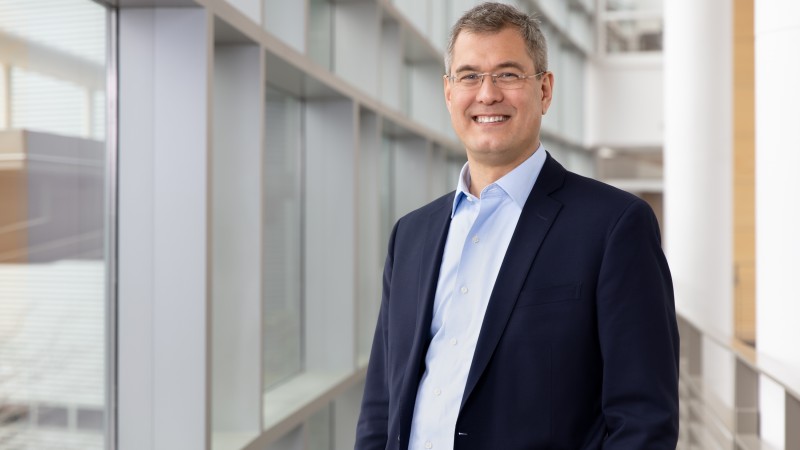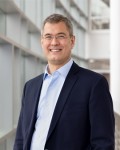From Denmark to Japan, the UK, France, and Sweden, physicist Ken Andersen has worked at neutron sources around the world. With significant contributions to neutron scattering and the scientific community, he’s now serving in his most important role yet.
Andersen leads two US neutron flagship facilities as the Associate Laboratory Director (ALD) for the Neutron Sciences Directorate (NScD) at the Department of Energy’s (DOE’s) Oak Ridge National Laboratory (ORNL).
“I’m very excited about having a part in helping to drive the organization forward,” he said. “My aim is to lead ORNL’s neutron user facilities to the highest possible levels of performance and source availability and help increase their scientific impact even further.”
“ORNL is a world leader in neutron sciences, and Ken brings a track record of international accomplishment to this critical position,” ORNL Director Thomas Zacharia said. “The research conducted at SNS and HFIR is advancing the understanding of materials and informing developments in energy, industry, technology and medicine. We are pleased to have Ken at the helm.”
For almost 30 years, Andersen has specialized in developing beamlines for user programs at world-leading neutron centers including the Institut Laue-Langevin (ILL), France; the ISIS Neutron and Muon Source at Rutherford Appleton Laboratory, UK; and the European Spallation Source (ESS), Sweden.
“I’ve always liked working things out, solving difficult problems. Math had sort of a certain glamour, I thought, and it always seemed to me like that’s what the clever people were doing,” said Andersen. “I had a great math teacher in school, and I think that’s what inspired me early on.”
Ironically though, he wasn’t much into physics before attending university, but that’s where he says he fell in love with the field and “messing about with equipment and trying to understand how things work.”
His inspiration to pursue neutron scattering came from another teacher, his physics professor, a beamline scientist at ILL. He earned his PhD in physics at Keele University in the UK while also working at ILL, where his neutron initiation formally began.
Born to Danish and Japanese parents, Andersen grew up in Copenhagen, Denmark. Wanting to learn more about his ancestry after completing his studies in Europe, he had the opportunity to work as a postdoctoral researcher at the National Laboratory for High Energy Physics in Tsukuba, Japan.
“That’s where I think I really developed my interest in building instruments,” he said. “At the time, some of the instruments there were sort of held together with sticky tape and string. If you wanted to build anything, you had to physically unstack the instrument, the shielding, and the sandbags. You literally had to build the instruments by hand.
“By then I was hooked on neutrons. Neutrons give you really unique information, but it wasn’t just about the information they give you, I also loved the instruments themselves. I loved figuring out how the instruments work and asking, ‘Why is it like that? Can’t we improve it by doing this?’ So, I got into improving instruments early as a PhD.”
After his postdoc appointment, Andersen was offered a position as an instrument scientist back in France at the ILL, working alongside the late Otto Schärpf on beamline D7. Andersen described D7 as sort of a hybrid between the HYSPEC and CORELLI instruments at ORNL’s Spallation Neutron Source (SNS). D7 incorporated technology invented by Schärpf that made it the first instrument in the world to do polarization analysis over a wide-angular-coverage detector.
“The work was demanding and could be difficult at times, but thinking back, working on D7 with Otto and learning polarization analysis was one of the best jobs I ever had. I absolutely loved it,” he recalled.
During that time, Andersen worked in proximity with another ILL instrument scientist, a name well-known to ORNL, former NScD ALD Paul Langan—Andersen’s predecessor. Andersen joked that neither one of them was successful in getting permanent jobs at ILL at the end of their 5-year contracts as instrument scientists. Langan moved on to work at Los Alamos National Laboratory, and Andersen likewise moved on to work at the ISIS facility. Their paths would cross again years later.
At ISIS, he worked on OSIRIS, an ambitious instrument project similar to D7, in which he investigated the feasibility of using polarized helium-3 gas instead of polarized supermirrors.
“In hindsight it wasn’t realistic,” he said, “but I chose that instrument project because it really pushed the envelope and I couldn’t help but think, ‘Wouldn’t it really be something if it actually worked?’”
A few years later, Andersen again returned to ILL, and again found himself crossing paths with another future NScD ALD when he took over for Ian Anderson as the head of neutron optics, his first job in management.
At ILL, Andersen was line manager for about 20 staff and oversaw research and development of the neutron instruments’ optical components and the optimization of instrument designs. His primary responsibilities included thin-film multilayers, helium-3 spin-filters, and crystal monochromators. He also participated in international collaborations on neutron instrumentation at other neutron sources. He spent 8 years as the head of neutron optics at ILL, which he says was a very formative period for him professionally.
In 2010, Andersen made another big move professionally. He decided to go from helping to build new instruments to also helping to build an entirely new facility at the ESS in Lund, Sweden.
“That was a leap of faith to leave ILL. But I’ve taken several leaps of faith during my career because I very much believe in taking opportunities when they come your way,” Andersen said. “In that way, I do see myself as a risk taker, because I like going out on a limb and trying new things.”
His job at ESS involved managing in-house teams and external partners working on the conceptual design, selection, procurement, development, and commissioning of new instruments. For 9 years, he worked on optimizing ESS instruments while also serving as an adjunct professor at the Niels Bohr Institute at Copenhagen University.
“You know, ILL is a very established place. It has a lot of inertia. ESS was brand-new, but as a startup, it was too exciting to pass up,” he said. “I was employee number 42, and when I left we were 500. It’s very exciting to be part of a new organization, but very chaotic. But I thrived on it; I really liked working out the structure of what looks like chaos.”
As the ESS moved closer from conception to realization, Andersen moved closer to what would be the biggest move of his career. In 2020, Andersen joined ORNL as the Division Director for Neutron Technologies.
“I saw tremendous opportunities at Oak Ridge. ORNL is a place with an incredibly rich history but also a place with a lot of new exciting things on the horizon. The Second Target Station is such a phenomenal project and there’s tremendous amounts of opportunities at the High Flux Isotope Reactor (HFIR) as well with the HFIR Futures Project,” he said.
“Coming here was another leap of faith, but I’m really pleased that I made the jump. It felt like a gamble leaving a well-established job in Sweden to cross the Atlantic, but Oak Ridge felt like the place to be and I certainly haven’t regretted it.”
Reflecting on his career and what brought him to this moment, he recalled a few lessons he learned as a young manager.
“When I was an early career scientist, what I wanted from my boss was to leave me alone, get out of my way and let me do what I needed to do; so as a manager, I imagined that’s what everyone wanted, and that was a mistake,” he said.
“My time at ILL taught me about the need to listen—meaning that other people have interests and points of view that you’ll never learn if you’re not prepared to listen to them,” he added. “It’s easy to jump to conclusions and make assumptions about what people want based on our own backgrounds, but the only way to find out what people want is to ask them.”
After spending most of his career so far abroad, Andersen is a well-known figure in the European neutron scattering community. He’s a believer in creating networks and working together to accomplish goals. He says the biggest challenge he expects to face as ALD is learning how to make the most of his new environment—building relationships with the other new ALDs and navigating the DOE system.
“I believe that people are fundamentally constructive. Figuring out what people are good at and putting them in positions where they can thrive and be fulfilled can be a complex problem. I really enjoy the aspect of reaching compromise and matching people’s interests,” he said. “If you can work out why you want to do this and how to align shared interests, that is the key to being able to move forward.”
When his busy schedule allows, Andersen enjoys cross-country running and playing classical piano. He has also played the violin. These days, he says, he plays music mostly by himself. When he was younger he played in the orchestra and played the bass guitar—“terribly”—in a rock band with his friends. During that time, he and one of his bandmates also formed a comedy band called the “Latin Lovers,” modeled after the easy listening Hawaiian-shirt-wearing band featured in the movie “The Blues Brothers”—the idea being, they were so good they were bad, or vice versa.
Andersen met his wife Alison at Keele University. They have three adult children, Hana, 25, Søren, 23, and Sacha 21—students in neuroscience, philosophy, and classical music, respectively. He’s fluent in Danish, French, English, and Swedish, and familiar with German and Japanese. And, as a runner, you might see the Copenhagen native jogging up Spallation Drive—seemingly thriving in chaos, in the cold, in shorts and a T-shirt.
SNS and HFIR are DOE Office of Science user facilities. UT-Battelle LLC manages ORNL for the DOE Office of Science. The Office of Science is the single largest supporter of basic research in the physical sciences in the United States and is working to address some of the most pressing challenges of our time. For more information, please visit www.energy.gov/science.—by Jeremy Rumsey






